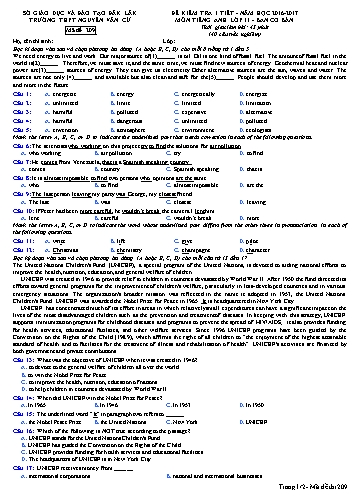Đề kiểm tra 1 tiết môn Tiếng Anh 11 (Ban cơ bản) - Mã đề 209 - Năm học 2016-2017 - Trường THPT Nguyễn Văn Cừ (Kèm đáp án)
Bạn đang xem tài liệu "Đề kiểm tra 1 tiết môn Tiếng Anh 11 (Ban cơ bản) - Mã đề 209 - Năm học 2016-2017 - Trường THPT Nguyễn Văn Cừ (Kèm đáp án)", để tải tài liệu gốc về máy hãy click vào nút Download ở trên.
Tóm tắt nội dung tài liệu: Đề kiểm tra 1 tiết môn Tiếng Anh 11 (Ban cơ bản) - Mã đề 209 - Năm học 2016-2017 - Trường THPT Nguyễn Văn Cừ (Kèm đáp án)

SỞ GIÁO DỤC VÀ ĐÀO TẠO ĐĂK LĂK ĐỀ KIỂM TRA 1 TIẾT - NĂM HỌC 2016-2017 TRƯỜNG THPT NGUYỄN VĂN CỪ MÔN TIẾNG ANH LỚP 11 - BAN CƠ BẢN Thời gian làm bài: 45 phút Mã đề 209 (40 câu trắc nghiệm) Họ, tên thí sinh:..................................................................... Lớp: ............................. Đọc kĩ đoạn văn sau và chọn phương án đúng (A hoặc B, C, D) cho mỗi ô trống từ 1 đến 5 We need energy to live and work. Our major source of(1)______ is oil. Oil is one kind of fossil fuel. The amount of fossil fuel in the world is(2)______. Therefore, we must save it, and the same time, we must find new sources of energy. Geothermal heat and nuclear power are(3)______ sources of energy. They can give us electricity. Other alternative sources are the sun, waves and water. The sources are not only (4)______ and available but also clean and safe for the(5)______. People should develop and use them more and more in the future. Câu 1: A. energetic B. energy C. energetically D. energize Câu 2: A. unlimited B. limit C. limited D. limitation Câu 3: A. harmful B. polluted C. expensive D. alternative Câu 4: A. harmful B. dangerous C. unlimited D. polluted Câu 5: A. envention B. atmosphere C. environment D. ecologists Mark the letter A, B, C, or D to indicate the underlined part that needs correction in each of the following questions. Câu 6: The scientists who working on this project try to find the solutions for air pollution A. who working B. air pollution C. try D. to find Câu 7: He comes from Venezuela, that is a Spainish speaking country. A. comes B. country. C. Spainish speaking D. that is Câu 8: It is almost impossible to find two persons who opinions are the same. A. who B. to find C. almost impossible D. are the Câu 9: The last person leaving my party was George, my closest friend A. The last B. was C. closest D. leaving Câu 10: If Peter had been more careful, he wouldn’t break the camera I lent him A. lent B. careful C. wouldn’t break D. more Mark the letter A, B, C, or D to indicate the word whose underlined part differs from the other three in pronunciation in each of the following questions. Câu 11: A. write B. life C. give D. pilot Câu 12: A. Christmas B. chemistry C. champagne D. character Đọc kỹ đoạn văn sau và chọn phương án đúng (A hoặc B, C, D) cho mỗi câu từ 13 đến 17 The United Nations Children's Fund (UNICEF), a special program of the United Nations, is devoted to aiding national efforts to improve the health, nutrition, education, and general welfare of children. UNICEF was created in 1946 to provide relief to children in countries devastated by World War II. After 1950 the fund directed its efforts toward general programs for the improvement of children's welfare, particularly in less-developed countries and in various emergency situations. The organization's broader mission was reflected in the name it adopted in 1953, the United Nations Children's Fund. UNICEF was awarded the Nobel Prize for Peace in 1965. It is headquartered in New York City. UNICEF has concentrated much of its effort in areas in which relatively small expenditures can have a significant impact on the lives of the most disadvantaged children such as the prevention and treatment of diseases. In keeping with this strategy, UNICEF supports immunization programs for childhood diseases and programs to prevent the spread of HIV/AIDS; it also provides funding for health services, educational facilities, and other welfare services. Since 1996 UNICEF programs have been guided by the Convention on the Rights of the Child (1989), which affirms the right of all children to "the enjoyment of the highest attainable standard of health and to facilities for the treatment of illness and rehabilitation of health". UNICEF's activities are financed by both government and private contributions. Câu 13: What was the objective of UNICEF when it was created in 1946? A. to devote to the general welfare of children all over the world B. to win the Nobel Prize for Peace C. to improve the health, nutrition, education of nations D. to help children in countries devastated by World War II Câu 14: When did UNICEF win the Nobel Prize for Peace? A. In 1965 B. In 1946 C. In 1953 D. In 1950 Câu 15: The underlined word "It" in paragraph two refers to ______. A. the Nobel Peace Prize B. the United Nations C. New York D. UNICEF Câu 16: Which of the following is NOT true according to the passage? A. UNICEF stands for the United Nations Children's Fund. B. UNICEF has guided the Convention on the Rights of the Child. C. UNICEF provides funding for health services and educational facilities. D. The headquarters of UNICEF is in New York City. Câu 17: UNICEF receives money from ______. A. international corporations B. national and international businesses Trang 1/2 - Mã đề thi 209
File đính kèm:
 de_kiem_tra_1_tiet_mon_tieng_anh_11_ban_co_ban_ma_de_209_nam.doc
de_kiem_tra_1_tiet_mon_tieng_anh_11_ban_co_ban_ma_de_209_nam.doc TA11_123_phieudapan.doc
TA11_123_phieudapan.doc

